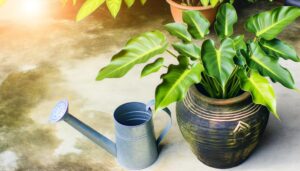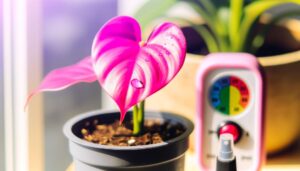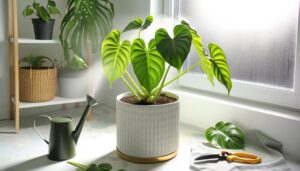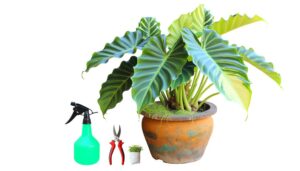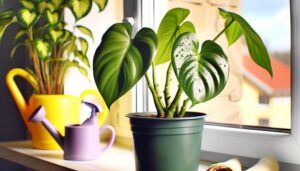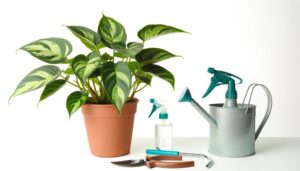What Are the Care Requirements for Philodendron Birkin Aerial Roots?
Philodendron Birkin's aerial roots require a specific set of conditions for optimal growth. Mainly necessitating a humid environment, correct watering techniques, and well-draining soil.
High humidity promotes nutrient uptake, while proper watering – avoiding both under and over-watering – prevents root rot. The appropriate soil mix, especially one that drains well, encourages root expansion and avoids waterlogging.
Importantly, environmental factors are not the only aspects of root health: root rot, a common issue, also requires careful consideration. Continue advancing through this informative guide to gain a deeper understanding of maintaining your Philodendron Birkin's health.
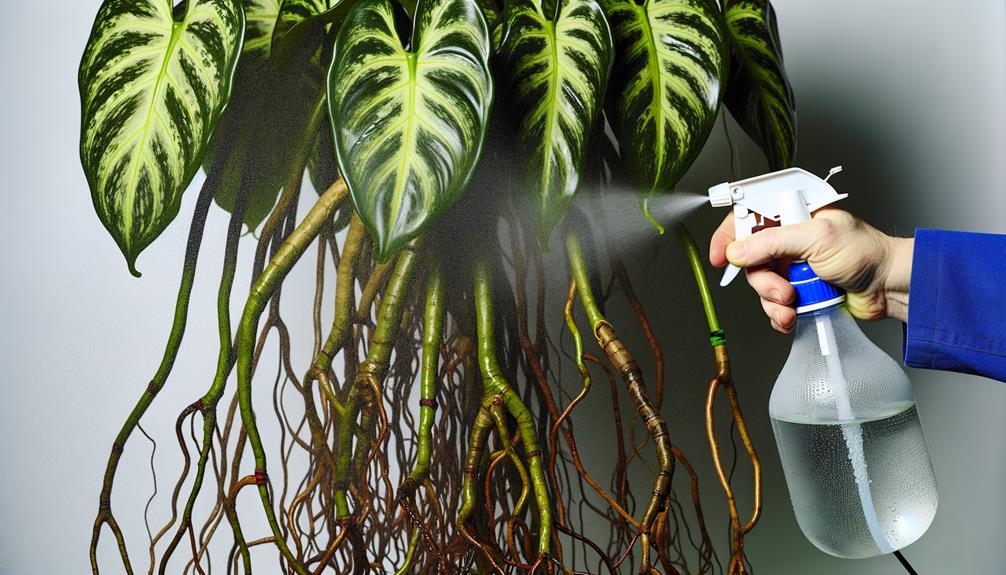
Key Takeaways
- Mimic rainforest conditions with gentle watering and high humidity for optimal aerial root health.
- Maintain room-temperature water to promote healthy root growth and avoid overwatering.
- Regularly inspect roots for signs of decay and prevent standing water in the pot to avoid root rot.
- Balance soil components to prevent waterlogging and promote root respiration, using a well-draining soil mix.
- Address challenges like improper watering, insufficient humidity, and poor lighting conditions that can impact root health.
Understanding Aerial Roots
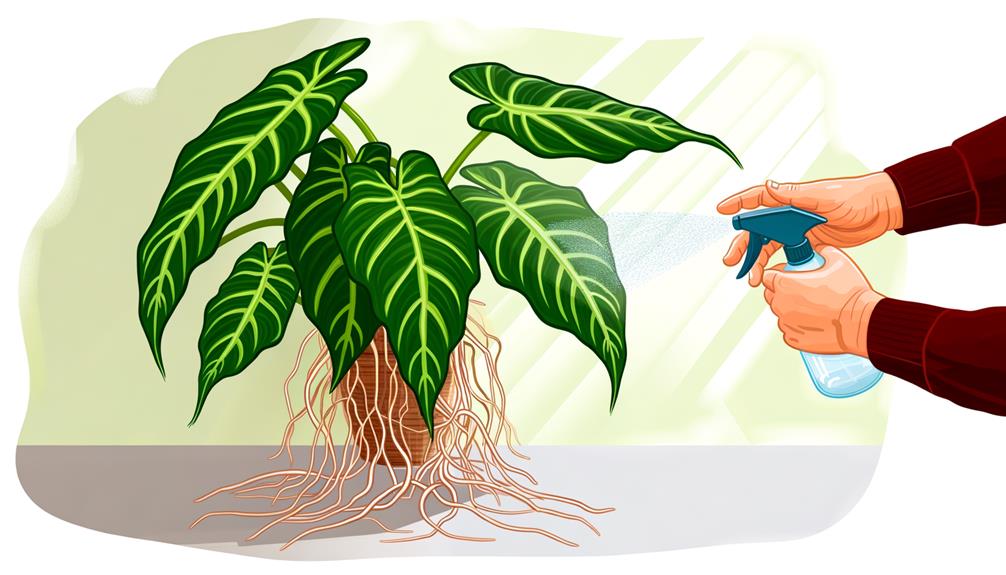
What are these fascinating growths we refer to as aerial roots in Philodendron Birkin, and what role do they play in the plant's survival and development?
Aerial roots in philodendrons are an adaptive feature that enables the plant to secure itself to supports and absorb nutrients and water from the air. These specialized roots proliferate from the plant's stem and are an essential part of its physiological structure.
They facilitate the plant's survival in diverse environments by assisting in nutrient uptake and enhancing stability. The ability to harness resources directly from the air sets these plants apart from other terrestrial species. Understanding these roots' function and characteristics is vital to providing ideal care and ensuring the longevity of your Philodendron Birkin.
Importance of Aerial Roots
While they may appear somewhat peculiar to the untrained eye, the aerial roots of Philodendron Birkin are of utmost importance due to their multifaceted roles in the plant's survival and growth.
These roots, protruding from the stem, perform essential functions such as absorbing moisture and nutrients from the air, a process known as epiphytism. This adaptation allows the plant to thrive in its native tropics where competition for resources at ground level is intense.
Additionally, aerial roots provide structural support, securing the plant to host trees or structures, aiding in vertical growth.
Hence, understanding and catering to the needs of these roots can greatly enhance the health and strength of your Philodendron Birkin, serving to fulfill your nurturing desires.
Ideal Environment for Growth
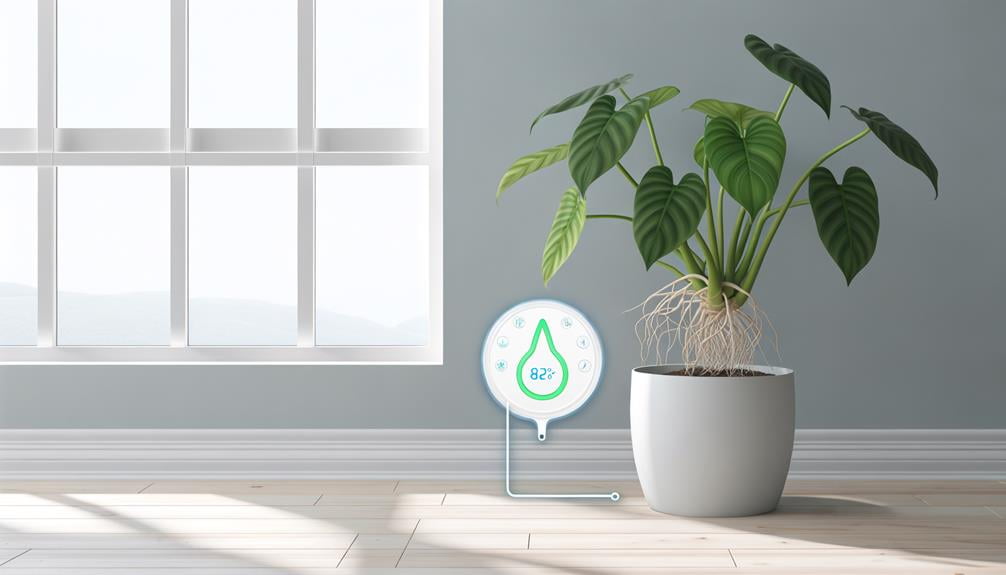
To foster ideal growth and development of Philodendron Birkin's aerial roots, it is critical to replicate the plant's natural, tropical environment as closely as possible, ensuring a balance of high humidity, warm temperatures, and indirect but bright light.
These conditions are pivotal for the plant's overall health and the development of its unique aerial roots. To provide a more detailed overview, the table below highlights these key aspects:
| Environment Factor | Ideal Condition | Impact on Aerial Roots |
|---|---|---|
| Humidity | High (60-80%) | Promotes root growth and maintains root health |
| Temperature | Warm (65-75°F) | Encourages root development, aiding in nutrient absorption |
| Light | Indirect, Bright | Promotes photosynthesis, essential for root and plant growth |
Watering Your Philodendron Birkin
Ensuring peak hydration, a crucial aspect of Philodendron Birkin care, involves maintaining a balance between sufficient watering and preventing waterlogging. Excessive moisture can lead to root rot, adversely affecting the health and growth of the plant's aerial roots.
The best watering regimen should take into account factors such as the plant's size, growth phase, season, and environmental humidity. A scientific approach suggests watering the plant once the top 1-2 inches of soil are dry. It is important to use water at room temperature to avoid shocking the plant's system.
Additionally, it might be helpful to think about misting the aerial roots directly. This practice can mimic the plant's natural rainforest habitat, promoting optimal hydration and enhancing overall plant health.
The Right Soil Mix
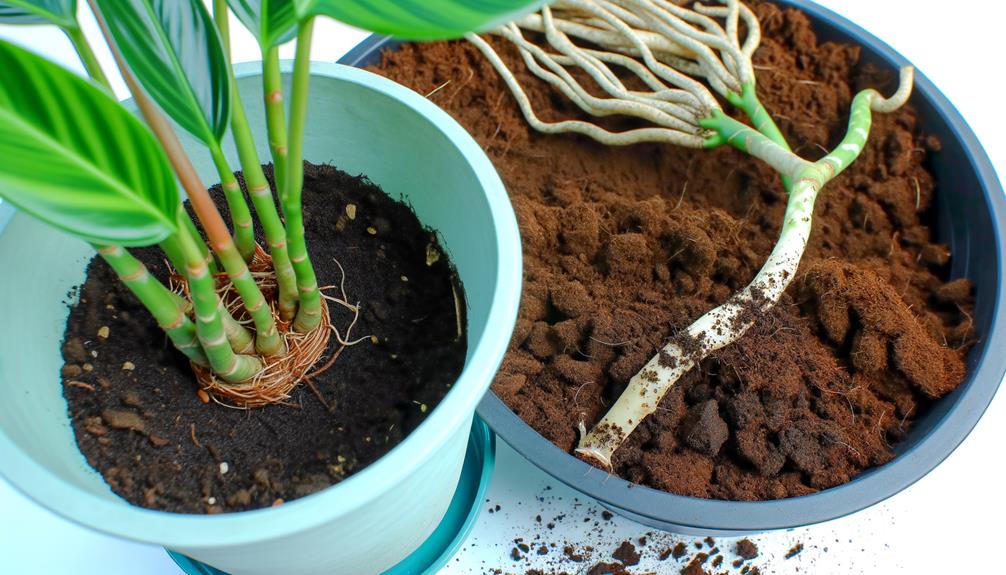
The appropriate selection of soil greatly influences the health and growth of Philodendron Birkin's aerial roots. A meticulous understanding of soil aeration is crucial, as it directly impacts root respiration, nutrient uptake, and overall plant importance.
Additionally, the incorporation of organic matter into the soil mix not only enhances its nutrient content but also optimizes the moisture retention capacity, creating an ideal growth environment.
Choosing the Perfect Soil
A best soil blend for Philodendron Birkin aerial roots requires a balance of well-draining components to prevent waterlogging and nutrient-rich elements to foster growth. The selection of an ideal soil mix is crucial to promote the plant's health and longevity, involving an intricate understanding of its specific needs and environmental adaptability.
A well-formulated soil mix should mainly contain peat or coco coir for moisture retention, perlite or pumice for drainage, and compost or worm castings for nutrients. The proportion of these components should be carefully balanced to ensure ideal conditions for growth.
For instance, an excessive amount of peat may lead to water retention issues, while inadequate compost might limit nutrient availability. Keep these considerations in mind when selecting the ideal soil for your Philodendron Birkin.
Importance of Soil Aeration
While the components of the soil mix play a vital role in plant growth, the structure of the soil, particularly its aeration, holds equal significance when cultivating Philodendron Birkin aerial roots.
A well-aerated soil facilitates the efficient exchange of gases between the roots and the atmosphere, ensuring the supply of oxygen necessary for root respiration. This fosters the development of a robust root system, leading to a healthier plant.
Conversely, poor soil aeration inhibits root function, leading to reduced nutrient uptake and stunted growth.
The use of a soil mix with good drainage properties, such as those containing perlite or sand, promotes soil aeration and is hence essential in the cultivation of Philodendron Birkin aerial roots.
Organic Matter Inclusion
Incorporating organic material into the soil mix proves crucial in promoting the growth and development of Philodendron Birkin aerial roots. Organic material enhances soil structure, improving drainage and aeration, both essential for healthy root development. It also provides necessary nutrients and fosters beneficial microbial activity.
A balanced soil mix, rich in organic material like compost, peat, or well-rotted manure, ensures optimal nutrient absorption. However, avoid excessive organic material as it can cause waterlogging, harmful to root health. Thus, a careful balance must be achieved. A typical ideal ratio might be 60% inorganic to 40% organic material.
This scientific approach to soil preparation not only boosts plant health but also contributes to a more sustainable and resilient plant care practice.
Fertilizer Needs of Philodendron Birkin
What type of fertilizer, then, best supports the growth and health of Philodendron Birkin's aerial roots?
Scientific analysis suggests a balanced water-soluble fertilizer, with a ratio of NPK 20-20-20, is ideal. This blend provides the essential nutrients—Nitrogen, Phosphorus, and Potassium—in equal proportions, promoting overall plant vitality.
Nitrogen enhances leaf development, Phosphorus aids in root formation and health, and Potassium fortifies the plant's immune system.
For best results, dilute the fertilizer to half-strength and apply monthly during the growing season, while reducing frequency to quarterly in the dormant period. Over-fertilization can lead to root burn, so precise dosage is important.
Pruning Aerial Roots: Yes or No?
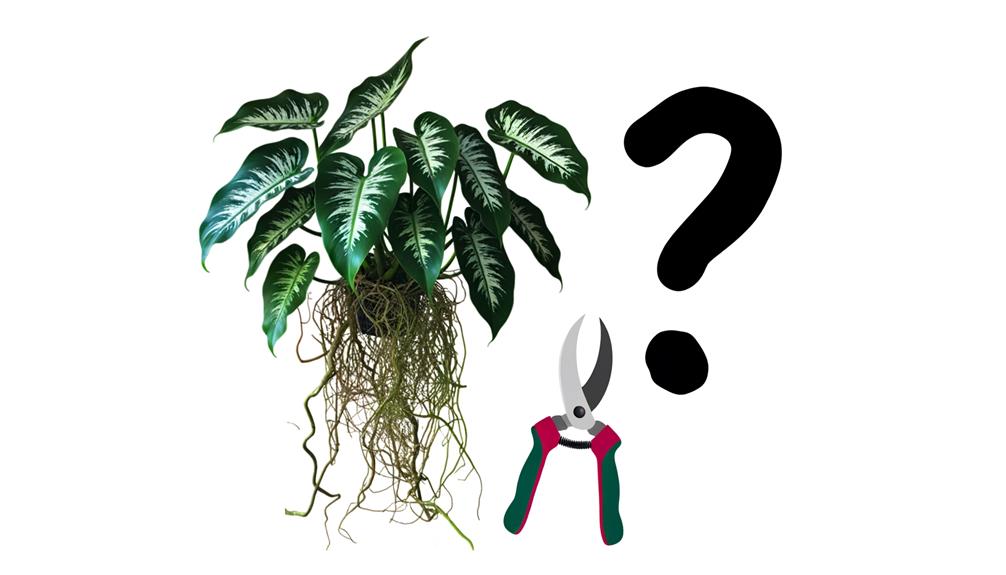
An essential consideration in the care of Philodendron Birkin involves the question of whether to prune its aerial roots or not, a topic that invites a blend of botanical science and horticultural technique.
Pruning is often perceived as a beneficial practice, aimed at maintaining both aesthetics and plant health. However, when it comes to Philodendron Birkin, a more judicious approach is advised. Aerial roots are a significant part of the plant's adaptive mechanism, allowing it to absorb additional nutrients and moisture from the environment.
Hence, indiscriminate pruning may hamper this functionality. Instead, focus on providing a supportive structure, such as a moss pole, for these roots to climb and thrive. This approach will foster plant health without impeding its natural growth pattern.
Dealing With Root Rot
Root rot is a common issue in Philodendron Birkin that often goes unnoticed until it causes significant harm to the plant. To assure the health and longevity of your Philodendron Birkin, it is essential to understand the symptoms and causes of root rot, and implement preventative measures.
Understanding the proper treatment methods for root rot can help restore the plant to its optimum health.
Identifying Root Rot Symptoms
In the care of Philodendron Birkin, it is important to detect the early signs of root rot, a common issue that can severely impair the plant's health if left untreated.
The symptoms of this ailment typically manifest in the form of yellowing leaves, a clear indication of a plant under stress. Additionally, a foul smell emanating from the potting soil is a strong indicator of root decay.
If the plant is removed from the pot, black, mushy roots as opposed to firm, white roots confirm the presence of root rot. Advanced stages may exhibit a general wilting or drooping of the plant.
Timely identification and intervention are critical to mitigate damage and restore the Philodendron Birkin to its best possible health.
Preventing Philodendron Root Rot
To prevent root rot in Philodendron Birkin, it is important to implement an integrated plant care approach that focuses on best watering practices, proper potting mix selection, and timely root inspections.
- Best Watering Practices:
Overwatering is a common cause of root rot. Make sure the plant is watered only when the top inch of the soil is dry, and avoid leaving standing water in the pot.
- Proper Potting Mix Selection:
A well-draining soil mix reduces water logging and subsequent root rot. Consider a blend of peat, perlite, and orchid bark.
- Timely Root Inspections:
Regularly checking the roots for signs of decay can help identify and isolate issues before they progress.
Root Rot Treatment Methods
How does one effectively combat root rot in Philodendron Birkin once it has taken hold? The key is to strike a balance between swift action and gentle care.
| Method | Procedure |
|---|---|
| Identification | Check for brown, mushy roots indicative of rot. |
| Root Pruning | Cut off affected roots using sterilized tools. |
| Repotting | Repot the plant in fresh, well-draining soil. |
| Fungicide | Apply a fungicide to prevent further rot. |
Identification is essential. Early detection leads to effective treatment. Root pruning, done carefully, removes the infected areas, halting the rot's spread. Repotting the plant gives it a fresh start in a healthier environment. Applying a fungicide is a preventative measure, ensuring the rot does not return. These steps, done with respect for the plant's needs, will restore your Philodendron Birkin to health.
Common Problems and Solutions
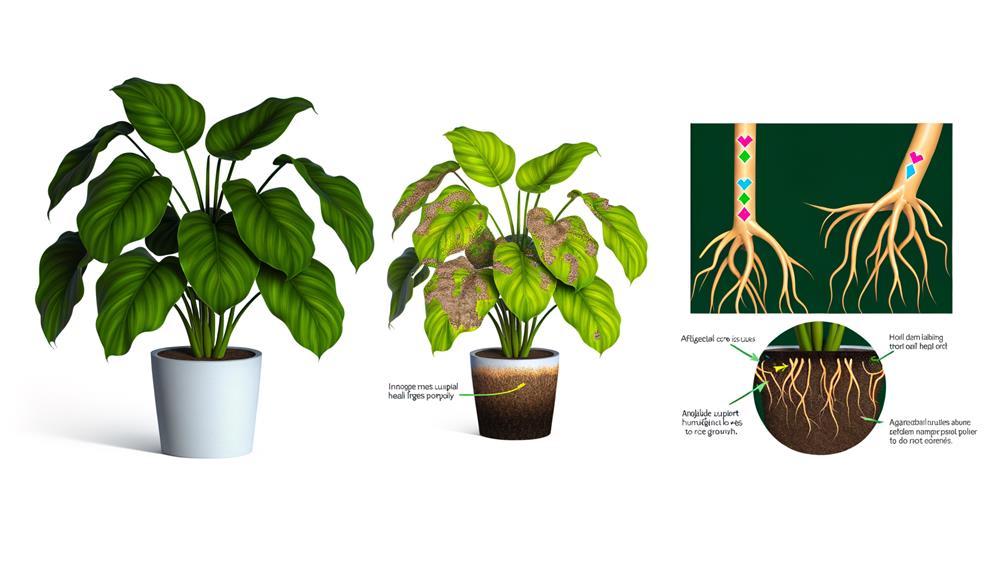
What are the frequent challenges faced when caring for the aerial roots of a Philodendron Birkin, and how can they be effectively addressed?
Primary issues arise due to improper watering, insufficient humidity, and poor lighting conditions.
- Improper Watering: Overwatering can lead to root rot. Maintaining a watering schedule that takes into account the plant's requirements and environmental factors is crucial.
- Insufficient Humidity: Philodendron Birkin thrives in high humidity. If the environment is too dry, consider using a humidifier or placing the plant on a water-filled pebble tray.
- Poor Lighting Conditions: This plant prefers bright, indirect light. Excessive direct sunlight can scorch the leaves and roots, while inadequate light can hinder growth.
Tips for Healthy Root Growth
Promoting robust growth of Philodendron Birkin's aerial roots requires a thorough understanding of their functions, best hydration practices, and ideal environmental conditions.
A detailed examination of these factors will arm us with the knowledge to create a favorable environment for the plant's root development.
The following discussion will clarify these essential elements, offering practical techniques to improve the health and strength of your Philodendron Birkin's aerial roots.
Understanding Aerial Root Functions
In the intricate world of botany, the aerial roots of a Philodendron Birkin serve multiple important functions. Primarily, they aid in nutrient absorption and provide structural support to the plant. These roots are an evolutionary marvel, adapted to fulfill the plant's needs in its natural habitat.
Nutrient Absorption:
Aerial roots absorb nutrients from the air, particularly in the form of moisture and dust particles. This is vital in their natural habitat where soil nutrients may be limited.
Structural Support:
Aerial roots anchor the plant to a support, providing stability and allowing for upward growth.
Water Storage:
Some aerial roots have the capacity to store water, ensuring the plant has a reserve in times of drought.
Understanding these functions aids in providing ideal care for these plants, thereby enhancing their strength and growth.
Optimal Watering Techniques
Given the multifaceted role of aerial roots in nutrient absorption, structural support, and water storage, it becomes evident that effective watering methods are a fundamental part of maintaining the health and supporting growth of a Philodendron Birkin. Consistent and evenly distributed watering guarantees that the plant's hydration needs are met without causing root rot or waterlogging. Interestingly, the application of water should imitate the plant's natural rainforest habitat, where rainfall is frequent but light.
Here is a table summarizing ideal watering techniques:
| Technique | Application | Effect on Roots |
|---|---|---|
| Regular, gentle watering | Mirror rainforest rainfall | Prevents waterlogging |
| Uniform distribution | Apply water around the entire root zone | Ensures all roots access water |
| Suitable timing | Water during cooler parts of the day | Prevents water evaporation |
| Check soil moisture | Before watering, assess soil moisture | Avoids overwatering |
| Use room-temperature water | Prevents shock to the plant | Promotes healthy root growth |
Suitable Environment Conditions
Harnessing prime growth and importance in Philodendron Birkin's aerial roots requires not only proper watering techniques but also the cultivation of suitable environmental conditions that closely mimic the plant's native rainforest habitat.
To foster robust growth, consider these key elements:
- Temperature: Birkins thrive in temperatures between 60-75°F. Sudden temperature fluctuations can stress the plant, impeding root development.
- Humidity: A high level of humidity, ideally around 60-70%, replicates the tropical rainforest atmosphere the Birkin prefers.
- Light: Indirect, but bright, light is essential. Direct sunlight can scorch the plant, while insufficient light can lead to weak root growth.
Tailoring your care to these environmental factors can significantly improve the health of your Philodendron Birkin's aerial roots, leading to a more vibrant, resilient plant.
Conclusion
To sum up, the successful care of Philodendron Birkin aerial roots requires a keen understanding of their growth conditions, such as the ideal environment, appropriate watering schedules, and the right soil mix.
Pruning, root rot prevention, and problem-solving are equally essential for healthy root growth.
Ultimately, meticulous attention to these factors guarantees the plant's best development, contributing to the aesthetic appeal and health of Philodendron Birkin.

